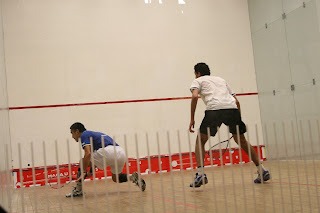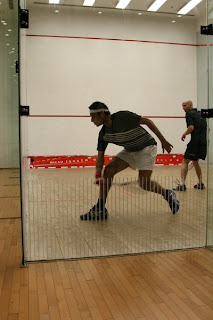The corners of the court are by far the most difficult areas to deal with. And saying that I mean both the back and the front corners. Usually players and coaches only talk about the back corners, and never really discuss the corresponding difficulties of the front corners. But I'd like to do so here.
The front and back corners are difficult for different reasons.
The back corner, as anyone who has had to hit a ball that has ended up there knows, is difficult because of the back wall restricting the racket swing. It is because of the back wall preventing a normal swing through to the ball, that many a boast are played as the seemingly only option.
And most of the time the boast played, it is a low boast the stays up front in the opposite corner. And of course this is exactly what the opponent has hoped for. Driving the ball into the corner, forcing a boast as the only option, and thus being able to amble up from the T, and softly return the boast with a drop into that front corner, very often for a clear winner.
The thing is, a low flying boast, is really only useful as an attacking shot, when you've got the opponent out of position. If your opponent is near the T when you hit a low boast, then really, you're only attacking yourself.
When we watch the top players, one should note that boasts hit out of the deep corners are almost always hit high, in particular when the striker is under pressure. Top players rarely hit low boasts out of the deep back corners, unless they are going for the surprise factor, or they are not under undue pressure.
The high boast out of the deep corners, does two things: it brings the ball back deeper into the court usually close to mid court, and the high boast gives the player time to move back to a more central location before the opponent will be able to hit the ball. The high boast that comes back to the mid court area, and gives the player sufficient time to return to the play, dramatically increases the odds that the player will be able to stay in the rally.
So all players who aspire to improve their games should be practicing and incorporating into their games the high boast out of the back corners.
------------------------------
Looking at retrieving shots hit into the front corners, really the two dominant shots are the straight drop and the crosscourt (either high or flat). And it should be noted that beginners to intermediate players tend to hit flat when going crosscourt.
When a player is at a stretch, running to the front corner, the natural full swing will pull the ball crosscourt, and the more the stretch the more likely the shot will have a flatter flight path.
As for the player moving to the front corner and dropping the ball straight, whether at a stretch or not, it can be very difficult to get the ball to stay along the wall, or drop into the nick. And yet a hitting a drop at this moment, is really only effective if the ball goes into the nick, or stays close to the wall. Otherwise, a drop that is out from the wall, simply invites the opponent to come in and drive the ball hard to the back. And at many levels of play this is an outright winning shot.
Going into the front corner, a player really has two options: play a drop, or hit a deep shot. The drop is hit when the player feels he can reverse the pressure and trouble the opponent. Alternatively, if the player feels pressure retrieving the ball in the front corner, then a high lob to the back court is really the best answer.
----------------------
The most common coaching point given to players when they move into the corners is to: bend the knees. This is the first and foremost teaching tip. Of course bending the knees is important for nearly all strokes in squash. And I'd argue that, even for overheads bending the knees, if possible, is best.
But there is something else that players need to focus on in order to develop their game in the corners:
In both the front and the back, a player can improve their consistency, their control, and increase options by doing one simple thing.
When swinging and hitting the ball, the player should do their utmost to get their hand and wrist down to the level of the ball itself, so that upon contact with the ball, the racket is in a near horizontal position.
Doing this puts the biomechanical pivot point of the wrist on the same plane as the ball, this is what increases the player's options, power, and control.
Of course bending the knees helps to accomplish this racket position, and knee bend aids in generation of power, but only the knee bend without the hand/wrist getting as low as the ball, will still result in a restriction of the player's options.
Getting the hand/wrist low not only makes such shots as the high boast much easier to hit, but it also allows the player to straighten out the swing and hit any number of shots along the wall, avoiding the boast completely.
In the front corners getting low with the hand/wrist does the same thing, it makes a high lob relatively easy, makes controlling direction more simple, so hitting straight or crosscourt are options, whether high and soft, or flat and fast. And with this low hand/wrist position it is much easier to control a drop, and place it softly into the wall or nick.
------------------
So the take away?
When you're going to the corners, focus on getting your hand/wrist down to same plane (level) where you'll hit the ball.
Once you're comfortable with hitting from this low hand position, then you can start developing your different shots: lobs, drives, drops, boasts, all from the same position (with the hand/wrist at the same level as the contact point).
As an instructor and coach in sport, and physical education beginning in 1980, I find it interesting that most written instructional materials for squash are written as if to take the novice on a path directly to the advanced level. As a coach, I instruct my students according to their skill level, giving them the building blocks piece by piece, thus development is not blocked by complexity, but actually growth is facilitated on a steady gradual learning curve appropriate to the individual.
Subscribe to:
Post Comments (Atom)

.JPG)





No comments:
Post a Comment
Thank you for your comments. I will get your comment up on the blog with a reply as soon as possible :-)